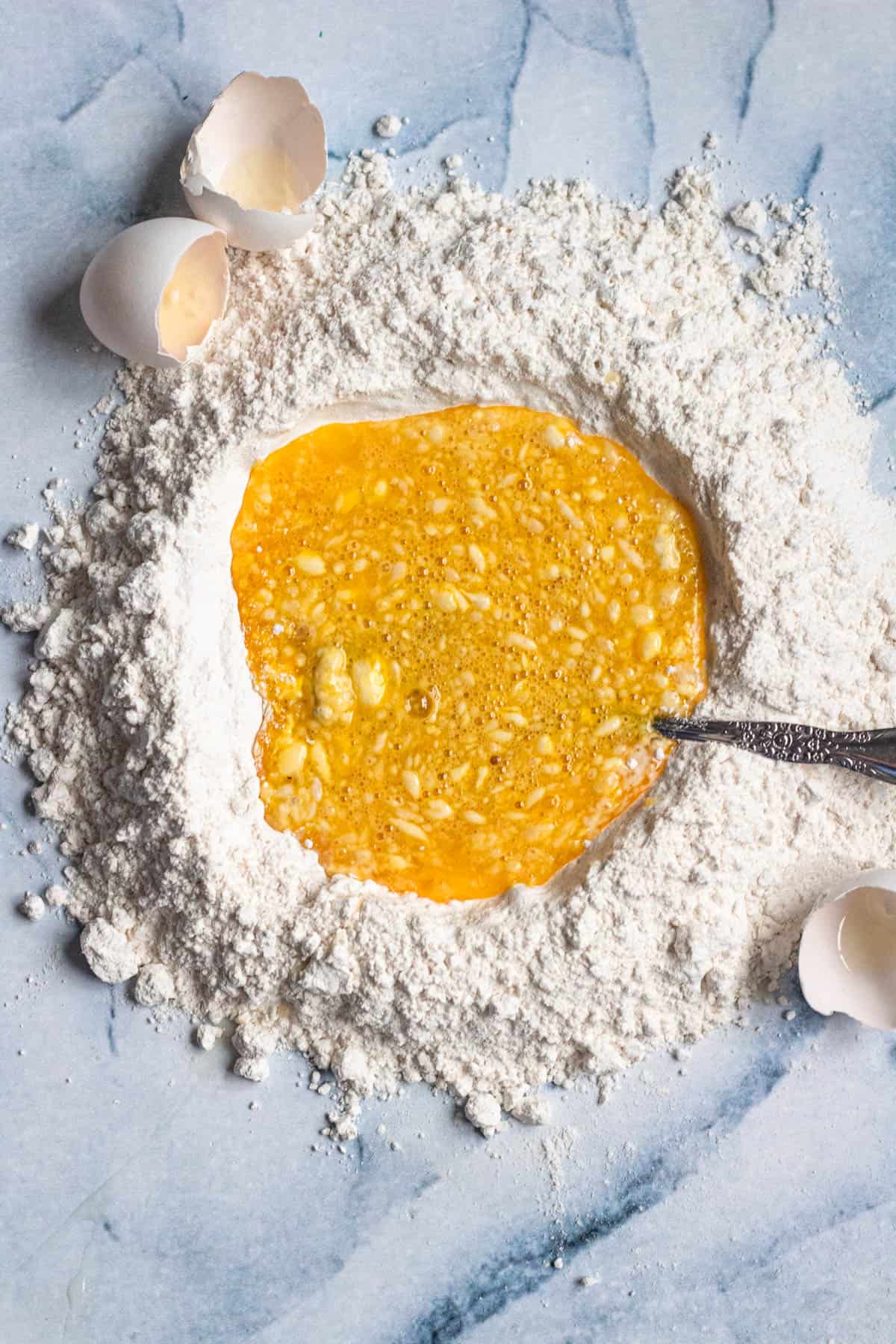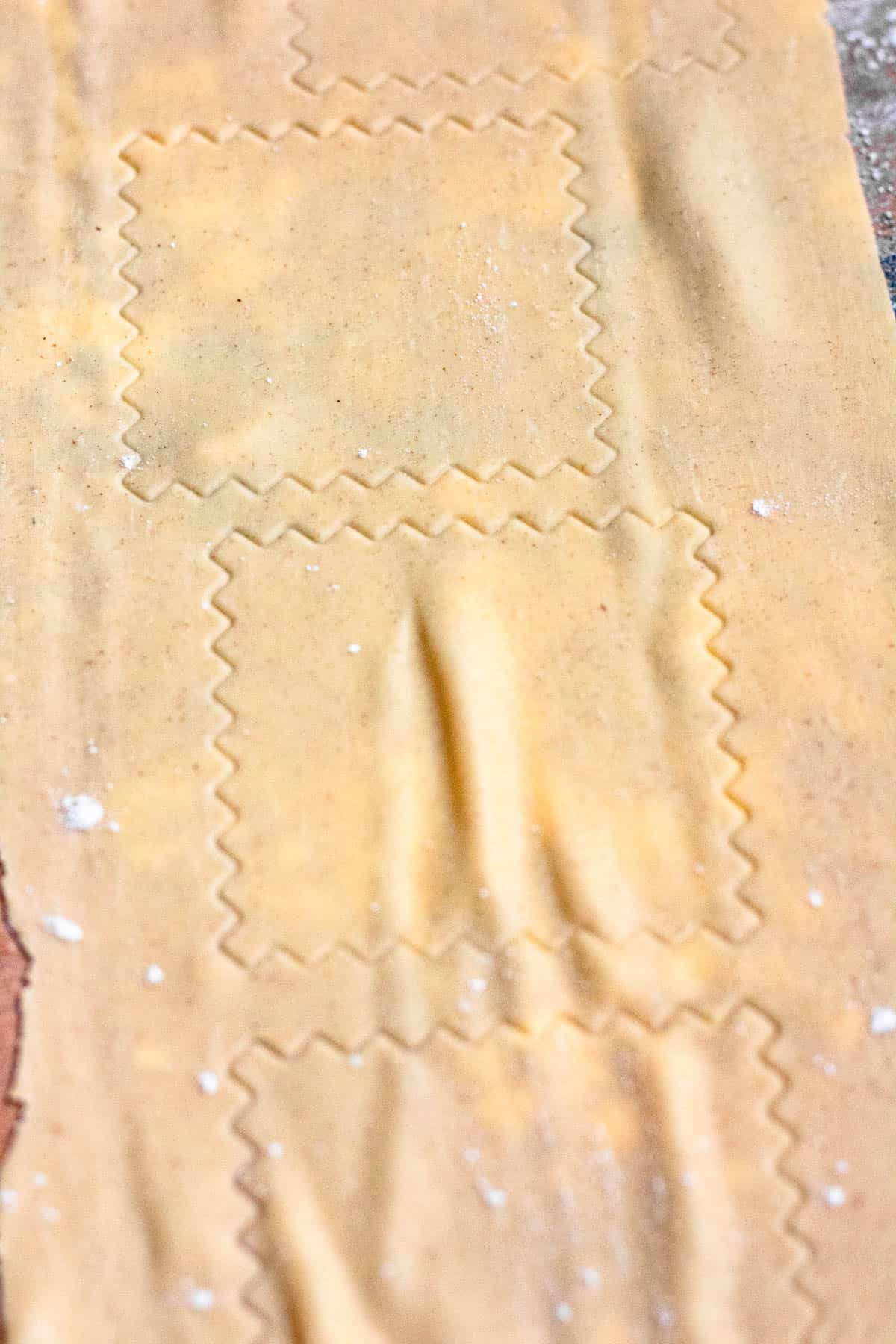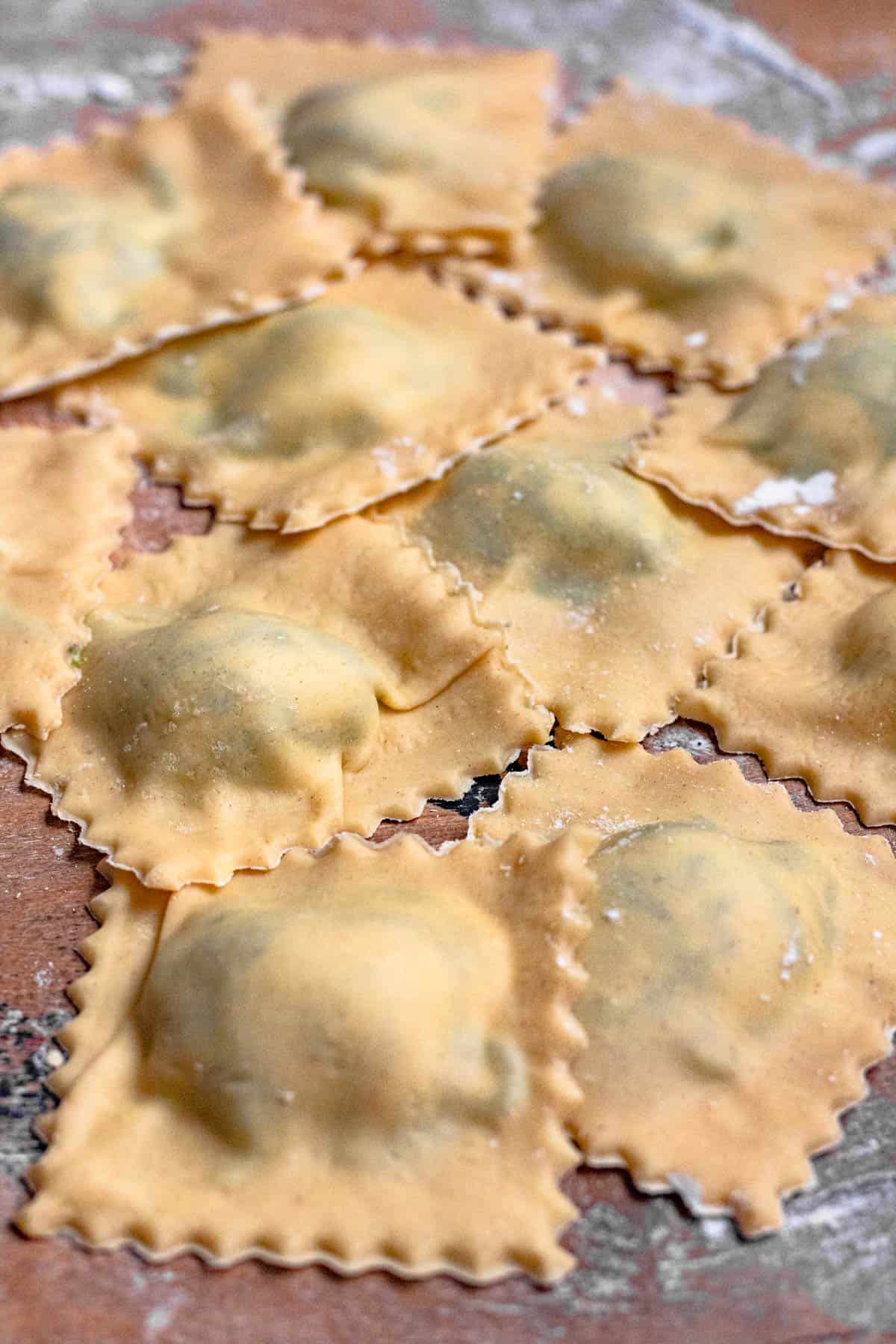Homemade Ravioli takes patience and technique, but the results are worth bringing the whole family together. Follow this recipe for perfectly delicious ravioli every time.

Hello Reader! I try my hardest to research recipes as best as I can before posting to ensure I am representing each culture correctly. If this recipe is from your country and I have made a mistake or you have suggestions for how to make it more authentic, I would love to hear! Please leave a comment below letting me know what should be different, and I will rework the recipe. It is always my intention to pay homage and respect to each cultural dish that I cook. Thanks for reading!
There is nothing like fresh, homemade ravioli. It’s a dish that is so beloved it has become a tradition among many families, with recipes passed down for generations.
It’s no secret that homemade ravioli takes some prep work. That’s why this dish is made most often on special occasions when families gather. Not only is it a family favorite, but when family is together, there are plenty of people to help with the preparation.
It’s possible to go to your local grocery store and find fresh or frozen ravioli on the shelf, but there is something about making it from scratch that makes it taste a million times better than store-bought ravioli. If you’re looking for an Italian favorite that’s a little quicker, but can stand up to the challenge of feeding a hungry crowd, Baked Mostaccioli recipe is the way to go. Make sure to pick up a loaf of freshly baked bread to go with your Italian dinner. Want to know the difference between French Bread vs Italian Bread? The key differences are explained in my article.
Recipe Origins
The exact origin of ravioli is difficult to place, but most agree that it has been enjoyed for centuries. Francesco di Marco Datini, an Italian merchant, provided the first written mention of ravioli.
Some people believe ravioli may have been created by Genova sailors, trying to preserve leftovers by wrapping them in pasta.
Eventually the recipe made its way to royalty and it became a delicacy, only enjoyed by those with the skill and time to be able to prepare it.
Over time ravioli became a dish that was shared among families. Each region came up with their own ideas for different fillings, and families would work together to prepare fresh ravioli for special occasions like holidays.
It’s common for Italian families to gather in the kitchen and preparing ravioli is a great excuse to call everyone together.
Why Make This Recipe
- Delicious: There is a huge difference in taste and texture between fresh and frozen ravioli. If you have never had fresh ravioli, you are missing out!
- Easier Than You Think: So many people are intimidated about making fresh homemade pasta, but if you follow these tips, I believe you will find ravioli is easier to make than you previously thought.
- Traditional Taste of Italy: This classic Italian ravioli recipe calls for authentic ingredients and the recipe was perfected while I studied in Italy. If you can’t travel to Italy, you can still get a taste of the real deal with this recipe.
What Do I Need To Make This Recipe?
Ingredients
Here is a visual overview of the ingredients in the recipe. Scroll down to the recipe at the bottom for quantities.

Pasta Ingredients
- All-purpose flour
- Eggs
- Salt
- Olive oil
Filling Ingredients
- Spinach: Baby spinach is best. I highly recommend using fresh spinach for this recipe
- Ricotta Cheese: It’s surprisingly easy to make your own at home!
- Parmesan Cheese: Grated. It is always a good idea to grate your own rather than using a bag of pre shredded.
Tools
- Ravioli Stamps – You can also hand cut your ravioli if necessary
How to Make This Dish
Step 1: Make the Pasta






Place the flour in a mound on the table.
Form a hole in the middle of the flour, deep enough to see the table at the bottom of the flour. Crack your eggs into the hole and add your salt and olive oil.
Use a fork to scramble the eggs inside the flour, slowly adding more flour as you go. The egg should turn into a paste.
When the mixture becomes thick, begin kneading with your hands. Press the heel of your hand into the dough to incorporate the flour. (You may not need all of the flour or add more depending on the consistency of your dough. It should be solid, not sticky or crumbling. Wet your fingers to add some water if your dough does not come together.)
Continue to knead the dough for 10-15 minutes until it is smooth and dark yellow. You can test if your dough is ready by pressing your finger into it. If the dough begins to bounce back instead of staying pressed in, then it is done. If it does not bounce back, continue to knead.
Form your dough into a ball and wrap in plastic wrap. Allow to rest at room temperature for about half an hour.
While the dough is resting, make your ravioli filling.
Step 2: Make the Ravioli Filling

Heat your olive oil in a pan over medium heat. Add the spinach to the pan and cook until the leaves are wilted.
Take your spinach off the heat and allow it to cool. When it is cool enough to touch, drain off any excess liquid. Use a cheesecloth or dish towel to wrap your cooked spinach and squeeze out the liquid.
Mix your cooked spinach with ricotta cheese, egg, salt, pepper, nutmeg and parmesan cheese. Set aside until you are ready to use it.
For more in-depth explanation on how to make ravioli filling, check out my article on my Ravioli Filling Recipe.
Step 3: Assemble the Ravioli




After allowing your pasta to rest for about a half hour, separate it into about 20 small sections.
Roll each section slightly on a floured surface and then pass it through your pasta rolling machine. Each pasta roller is different, but start with your widest setting and work your way thinner.
You may need to pass your dough through each setting two or three times to ensure it does not crack or break.
You want your ravioli pasta to be rolled thinner than you would roll fettuccine noodles. Do not go all the way to the smallest setting, but 1-2 away from the smallest setting should be sufficient. Leave the dough you are not working with wrapped in the saran wrap.
Dust a clean countertop or board with flour. Place a rolled out piece of pasta on the board. Use your ravioli stamp to lightly press an indent into the pasta to mark out the ravioli shapes. You can use this to indicate where to place the filling.
Place about 1½ tsp of filling in the middle of each stamped area. Once all spaces are filled, place a second sheet of dough on top.
Use your hands to press the space around the filling to remove any extra air. Then use the ravioli cutter to cut out the ravioli. Repeat this process until all dough and pasta is used up.
Step 4: Cook Your Pasta
To cook the ravioli fresh, salt a large pot of water and bring it to a boil. Add the ravioli into the salted water. Cook until the ravioli floats, then continue to cook for another 30-60 seconds, until the pasta is cooked to al dente.
Drain and serve with a sauce of your choice. Enjoy!
Expert Tips:

- Some homemade ravioli recipes call for mixing your dough in a food processor. This works, but it may lead to you accidentally using more flour than you want. I like to combine the flour slowly because the size of your eggs may change the exact measurements needed.
- Measuring in grams of flour is difficult for some people but I’ve found it’s the key to perfecting your own pasta dough.
- If you have any leftover filling you can use this incredible filling for manicotti or stuffed shells. Save it in a small bowl and cover it with plastic wrap.
- This is the best homemade ravioli because it is great with so many different sauces. Marinara sauce, alfredo sauce, or just some sage and butter on top. Delicious!
Shaping your Ravioli

You can roll your pasta by hand with a rolling pin and cut your ravioli with a knife if necessary! But for the best, most consistent ravioli, it is a good idea to use a pasta machine. For more in depth instructions on how to use a Kitchenaid Pasta attachment, read this post on How the Kitchenaid Pasta Attachment Saved My Life.
A ravioli mold is also helpful to make sure your pasta sheets are not overfilled.
Tips on Boiling Fresh Ravioli
Be careful about the temperature of your water. If it is boiling too quickly when you add your pasta, your pockets will open up. Cook it too slowly and you will get soggy pasta. You want your water to be boiling, but not too much. Stir carefully when your ravioli are cooking and then remove them from the water with a slotted spoon.
Fresh pasta cooks very quickly, so keep an eye on your ravioli. It should cook completely within 3-4 minutes. For more information on how fast ravioli cooks, check out this post about How Long to Boil Fresh Ravioli! Ravioli is a little bit different than cooking your typical Fettucine. Know How Long To Cook Homemade Pasta with the information I share in this article.
FAQs

Yes, you can save fresh, homemade ravioli in the freezer. Place it on a baking sheet and freeze the dumplings separately before transferring to an airtight container.
You can also save fresh ravioli in the refrigerator for two to three days before cooking. Once cooked they can be kept in a container in the refrigerator for about two days.
If you are pressing carefully you do not need an egg wash in between your two sheets of dough. If you notice they are not sticking together well, try sealing with a drop of water.
Homemade ravioli will fall apart if the dough gets too wet. This could happen during the making of your dough, or it could be because your filling is too wet. Make sure you drain your spinach well next time. The filling should be thick, a little thinner than a block of cream cheese.
Semolina flour is traditionally used for pasta recipes but I’ve had good success using plain all purpose flour.
- Authentic Italian Sausage and Peppers
- Italian Dessert Recipes
- Substitute for Italian Herbs
- Easy Tiramisu Recipe

Italian Ravioli Recipe
Equipment
- Ravioli Stamps
- Plastic Wrap
- Pasta Maker
- Cheesecloth
- Mixing Bowl(s)
- Pot(s)
- Pan(s)
Ingredients
Pasta Ingredients
- 1000 grams all-purpose flour
- 10 eggs
- ¾ tsp salt
- 2 ½ tsp olive oil
Filling Ingredients
- 1 tbsp Olive Oil
- 12 oz baby spinach leaves, see notes about chopping
- 15 oz fresh ricotta cheese
- 1 large egg
- ½ tsp Salt
- ¼ tsp Pepper
- ¼ tsp Nutmeg
- ½ cup parmesan cheese, Grated
Instructions
Make the Pasta
- Place 1000 grams flour in a mound on the table.
- Use your hand to form a well in the middle of the flour. You should be able to see the table at the bottom of your flour.
- Crack 10 eggs into the hole in the well. Add your ¾ tsp salt and 2 ½ tsp olive oil.
- Use a fork to scramble the eggs inside the flour well. As you mix, use your fork to slowly incorporate flour from the edges of the well. Slowly keep adding more flour with your fork as you stir. The egg should turn into a paste.
- When the mixture is too thick to mix with a fork anymore, start kneading with your hands. Make sure to press with the heel of your hand, working the flour into the dough. (You may need to not incorporate all of the flour or add more depending on the consistency of your dough. The dough should not be sticky or crumbly. It should be a happy medium in between. If your dough is too dry, wet your fingers with some water and continue to knead the dough.)
- Knead the dough for 10-15 minutes until the dough is smooth and has turned a darker yellow color. You can test if your dough is ready by pressing your finger into it. If the dough begins to bounce back instead of staying pressed in, then it is done. If it does not bounce back, continue to knead.
- Form your dough into a ball and wrap in plastic wrap. Allow to rest at room temperature for about half an hour.
- While the dough is resting, make your ravioli filling.
Make the Ravioli Filling
- Place a large pan over medium heat and add 1 tbsp olive oil. Then add 12 oz spinach leaves into the pan and cook, stirring occasionally, until the spinach leaves are wilted.
- Allow the cooked spinach to cool. When it is cool enough to touch, pour it into a clean dish towel or cheesecloth. Squeeze all of the excess water from the spinach.
- In a medium bowl, mix the cooked spinach, 15 oz ricotta cheese, 1 egg, ½ tsp salt, ¼ tsp pepper, ¼ tsp nutmeg, and ½ cup parmesan cheese together.
- Set aside as you roll your pasta.
- Assemble the Ravioli
- When the pasta is done resting, it is time to roll out the dough to assemble your ravioli.
- Cut the dough into small sections (about 20).
- Pass these sections through the pasta roller on your pasta machine. Because each pasta maker is different I cannot give the numbers of the settings, but choose a thicker setting, then a medium setting, and finally a thin setting (on my Kitchenaid Pasta Maker, I run the pasta through the #1, then #3, then #5, then #7). You want your ravioli pasta to be rolled thinner than you would roll fettuccine noodles. Do not go all the way to the smallest setting, but 1-2 away from the smallest setting should be sufficient. Leave the dough you are not working with wrapped in the saran wrap.
- Dust a clean countertop or board with flour. Place a rolled out piece of pasta on the board. Use your ravioli stamp to lightly press an indent into the pasta to mark out the ravioli shapes. You can use this to indicate where to place the filling.
- Place about 1½ tsp of filling in the middle of each stamped area. Once all spaces are filled, place another pasta sheet on top.
- Use your hands to press the space around the filling to remove any extra air. Then use the ravioli stamps to cut out the ravioli. Repeat this process until all dough and pasta is used up.
Cook the Ravioli
- To cook the ravioli fresh, salt a large pot of water and bring it to a boil. Add the ravioli into the water. Cook until the ravioli floats, then continue to cook for another 30-60 seconds, until the pasta is cooked to al dente.
- Drain and serve with your favorite sauce. Enjoy!
Video
Notes
- All-purpose flour
- Eggs
- Salt
- Olive oil
- Spinach: Baby spinach is best. I highly recommend using fresh spinach for this recipe
- Ricotta Cheese: It’s surprisingly easy to make your own at home!
- Parmesan Cheese: Grated. It is always a good idea to grate your own rather than using a bag of pre shredded.
- Some homemade ravioli recipes call for mixing your dough in a food processor. This works, but it may lead to you accidentally using more flour than you want. I like to combine the flour slowly because the size of your eggs may change the exact measurements needed.
- Measuring in grams of flour is difficult for some people but I’ve found it’s the key to perfecting your own pasta dough.
- If you have any leftover filling you can use this incredible filling for manicotti or stuffed shells. Save it in a small bowl and cover it with plastic wrap.
- This is the best homemade ravioli because it is great with so many different sauces. Marinara sauce, alfredo sauce, or just some sage and butter on top. Delicious!






Leave a Reply